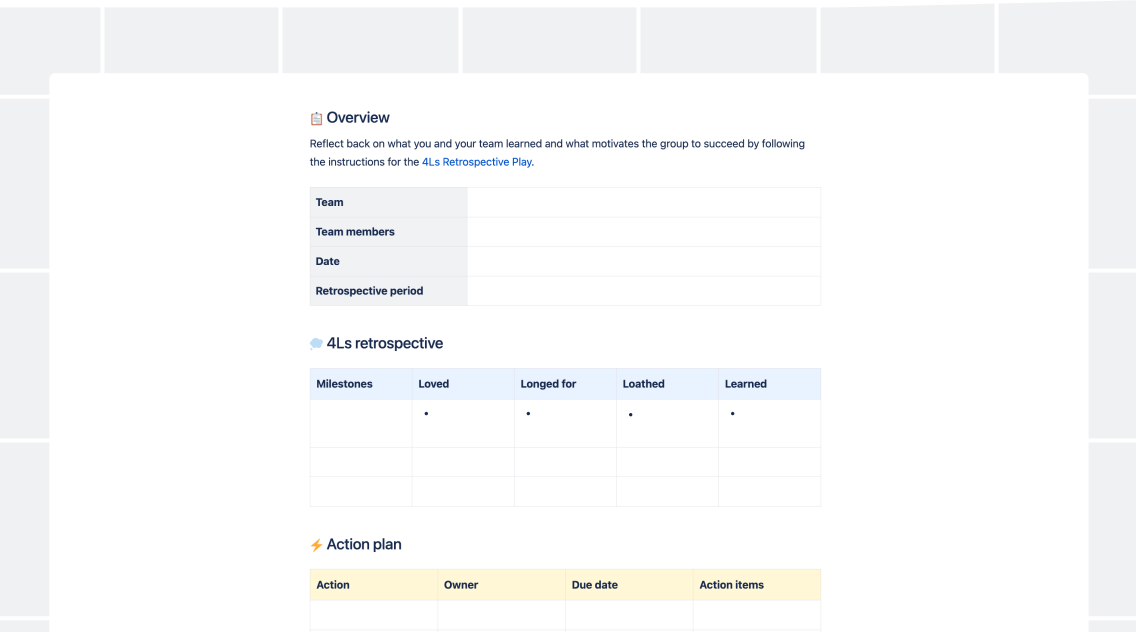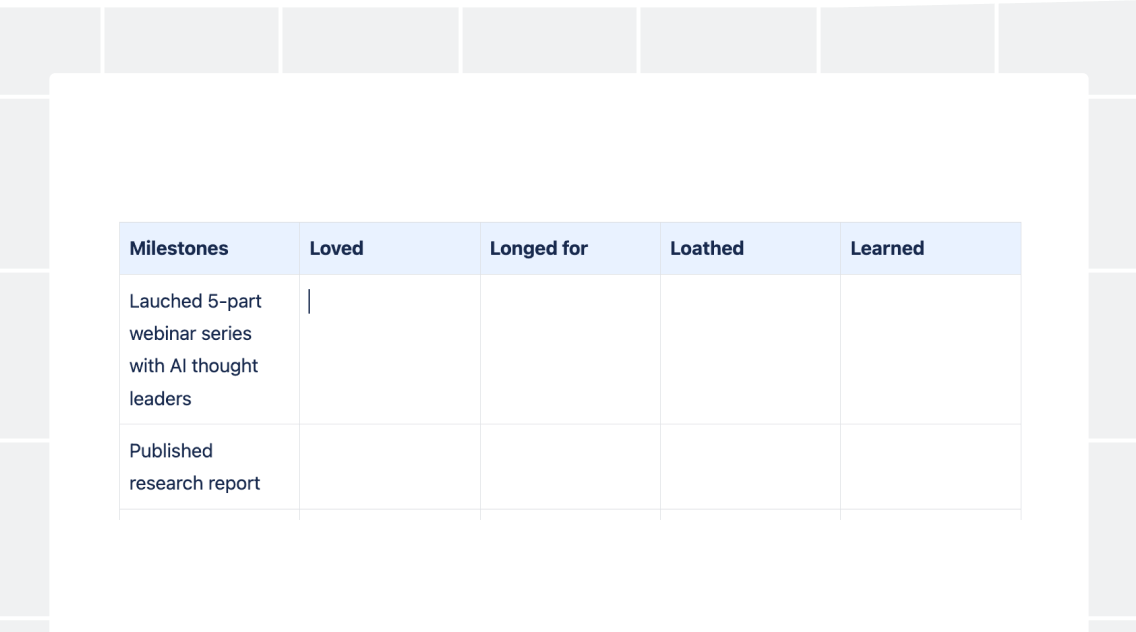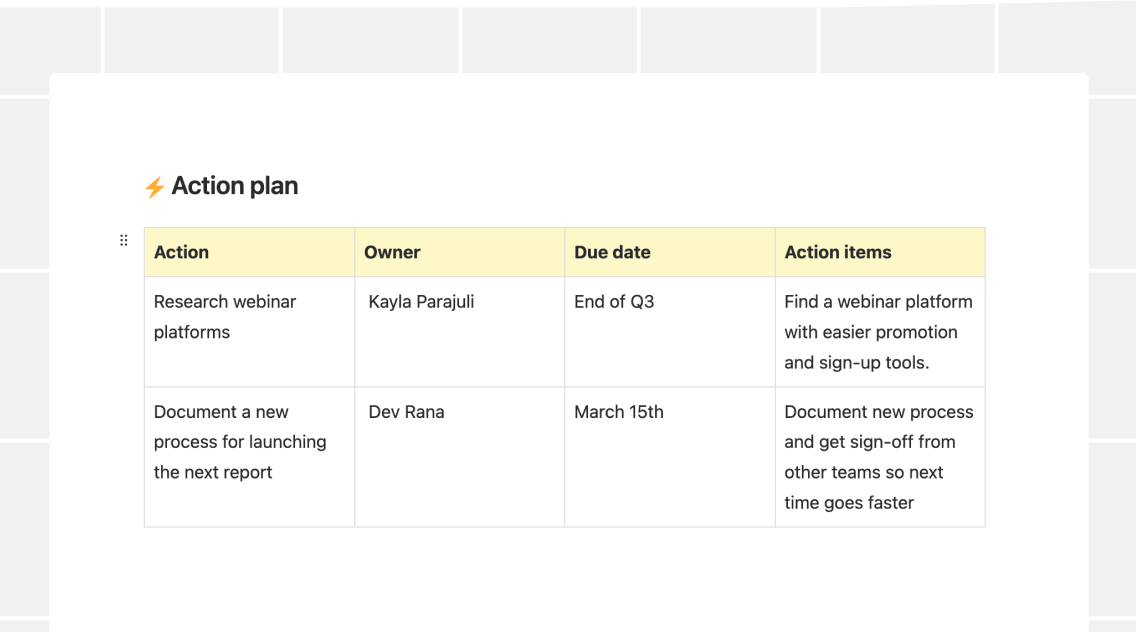4Ls Retrospective
Build a culture of openness and continuous improvement with the 4Ls, a retrospective technique in which team members identify what they loved, loathed, longed for, and learned from a project or sprint of work.

PREP TIME
5m
Run TIME
60m
Persons
2-8
5-second summary
- Reflect on past key milestones.
- Discuss the 4Ls for each milestone.
- Document an action plan to improve.
WHAT YOU WILL NEED
- Video conferencing with screen sharing or meeting space.
- Digital collaboration tool (see templates).
- Optional: physical whiteboard, markers, sticky notes, and timer.
How to run a 4Ls Retrospective
Build a culture of openness and continuous improvement with the 4Ls, a retrospective technique to identify what you loved, loathed, longed for, and learned from a project or sprint of work.
What is a 4Ls retrospective?
A 4Ls retrospective is a structured feedback technique used by teams to reflect on a completed sprint or project so they can improve future projects.
The "4Ls" stand for Loved, Loathed, Longed for, and Learned. Here's what each of them represents:
- Loved: What went well during the project? These are the things that team members appreciated, enjoyed, or found to be effective.
- Loathed: What made things worse? What was missing or needs improvement? This category identifies gaps, such as missing resources, skills, or support that would have made the sprint more successful.
- Longed for: What do team members wish they’d had during the sprint? This could be anything that would have made the work more efficient or enjoyable, like better tools, clearer requirements, or more time.
- Learned: What new knowledge or skills did the team gain? This could be technical knowledge, better communication methods, or insights into the project or process.
Why run a 4Ls Retrospective Play?
Retrospectives promote continuous learning, helping teams refine workflows and techniques, and ensure more effective project delivery in the future. Research shows that teams practicing regular retrospectives are 24% more responsive, have 42% higher quality, and less variable than those with infrequent or no retrospectives.
When should you use a 4Ls retrospective?
The 4Ls retrospective can be adapted to different team dynamics, project phases, and time frames. It’s not limited to just the end of a sprint or tech teams; it can also be used formally at the end of a project, a release, or significant events or impromptu to improve team meetings.
3 benefits of the 4Ls retrospective
- Balanced feedback: The 4Ls framework encourages a balanced reflection by covering both positives and areas for improvement.
- Action-oriented: The 4Ls framework pinpoints specific areas that need improvement, making it easier to create targeted action plans for future sprints.
- Positive framing: The 4Ls framework maintains a constructive tone during the retrospective, focusing on opportunities rather than just problems.
1. Prep your team and 4Ls document
Est. time: 5 MIN
For remote teams, start by creating a collaboration document, like a Confluence page. You can use the available templates or create your own. For in-person teams, get a whiteboard or large piece of paper, along with sticky notes and markers, in a meeting room.
Before the session, decide as a team on the retrospective time frame. If your company operates on a quarterly schedule, it's a good idea to look back on the last quarter.
Organize six columns titled Milestones, Loved, Loathed, Longed for, Learned, and Actions.
At the meeting's outset, communicate the following to your team:
- Our purpose today is to reflect on what’s working and what’s not working
- This is not a blame game or finger-pointing session
- We acknowledge that everyone did their best with the knowledge and tools available
This meeting is a safe space; shared insights will not be used against anyone
2. Reflect on key milestones
Est. time: 10 MIN
Ask the team to recall significant moments from the chosen period, like goals met, celebrations, new members, and company events. This helps recall memories and feelings. Set a 10-minute timer for everyone to add their key events to the Milestones column.
3. Define the 4Ls
Est. time: 10 min
Set a 10-minute timer for everyone to fill out their 4Ls for each milestone. Prior to starting, explain the 4Ls to the team:
- Loved: What you enjoyed and want to continue
- Loathed: What didn’t you enjoy
- Longed for: What you wish you had (i.e. resources, people, guidance, etc.)
- Learned: Lessons from successes and mistakes
4. Discuss actions to improve
Est. time: 10 min
Give everyone 10 minutes, either as a team or in breakout groups, to decide:
- One action to remove something from the Loathed list
-
One action to amplify something from the Loved list
The items listed in the Longed for and Learned columns can help inform the action items you’ll commit to.
TIP: FOCUS
The fewer actions you have to take, the more likely it is you’ll get them done. Start with just one action item for each list.
5. Share and capture plans
Est. time: 10 min
Give each group a few minutes to present their plan. Use the actions list to record:
- Who will do it
- What they are doing
- When they’ll have it done
Follow-up
Schedule and revisit the 4Ls Retrospective Play on a regular cadence that works best for your team (e.g., once a quarter or after project cycles). Revisiting the 4Ls is important because it builds accountability for action items and creates a consistent team ritual.

Still have questions?
Start a conversation with other Atlassian Team Playbook users, get support, or provide feedback.
Other plays you may like
Meetings
Weekly Team Updates
Share how things are going—without scheduling another meeting.
Meetings
Page-Led Meetings
Better meetings start with a page that outlines the purpose, expected outcomes, and key discussion points.
Communication
User Manual
Help your teammates understand how best to work with you.
Debrief
Retrospective
Provide a safe space to discuss what worked and what didn’t.
Stay up to date
Get the latest Plays and work life advice when you sign up for our newsletter.










